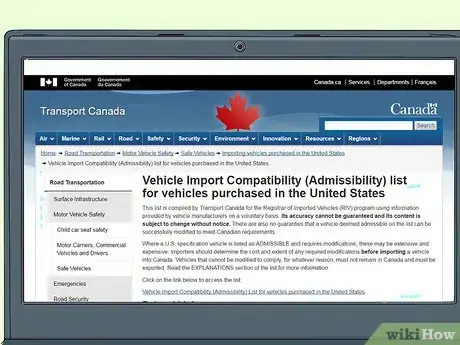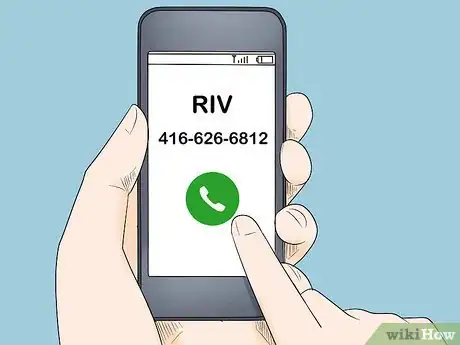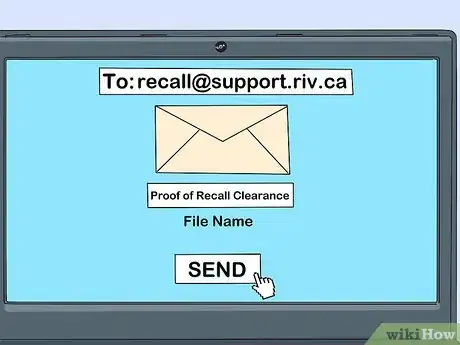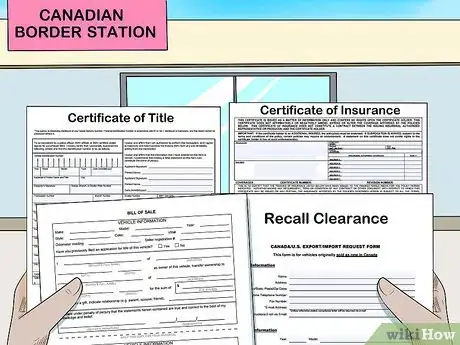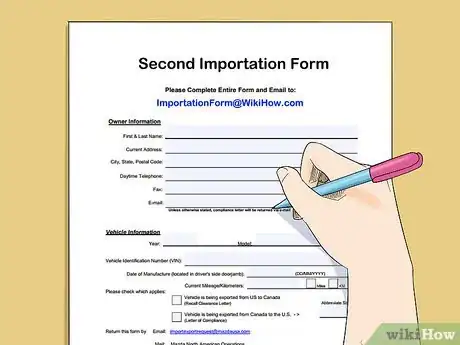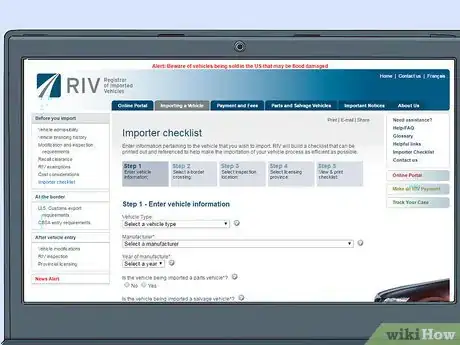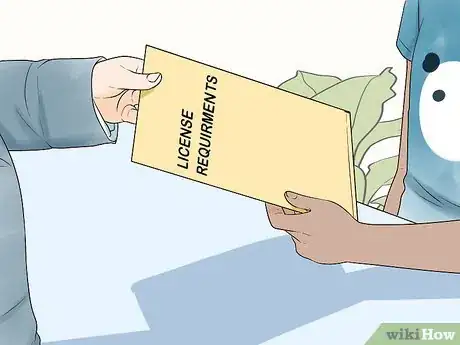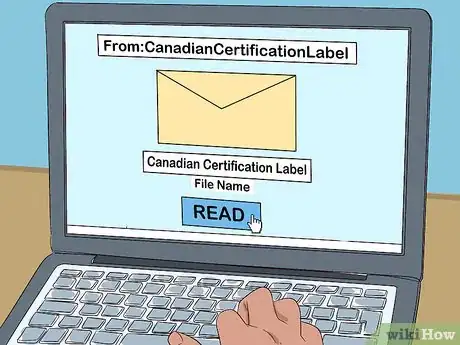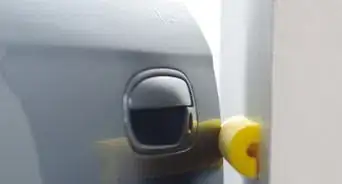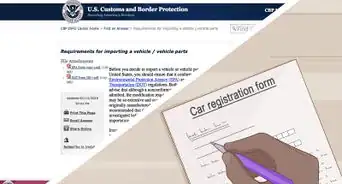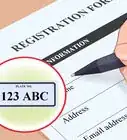This article was co-authored by wikiHow Staff. Our trained team of editors and researchers validate articles for accuracy and comprehensiveness. wikiHow's Content Management Team carefully monitors the work from our editorial staff to ensure that each article is backed by trusted research and meets our high quality standards.
There are 10 references cited in this article, which can be found at the bottom of the page.
This article has been viewed 93,549 times.
Learn more...
Whether you're moving to or are selling a car in Canada, you will need to import your vehicle before it can be legally driven in any Canadian province. So long as you begin the importation process several weeks in advance, importing a car is simple and straightforward. If you meet import requirements and have brought all required documents to the US and Canadian customs stations, you should be able to bring your car into the country. After finishing importation forms and the Registrar of Imported Vehicles (RIV) inspections, your car can be legally used in Canada.
Steps
Meeting Import Requirements
-
1Check Transport Canada’s list of approved car models to make sure you can import the car. For a vehicle to be imported into Canada from the United States, it must be on Transport Canada’s list of permissible makes and models. If you have any questions about your particular car model, contact Transport Canada about your questions.
- You can access Transport Canada’s list of approved vehicles here: http://www.tc.gc.ca/eng/motorvehiclesafety/safevehicles-importation-usa-vafus-menu-475.htm
-
2Contact the Registrar of Imported Vehicles (RIV) and Transport Canada about any potential modifications. In some cases, you may need to make a few modifications to your car before importing your vehicle into Canada. Contact both the RIV and Transport Canada to receive a list of modifications to make on your vehicle before entering Canada.[1]
- You can contact the RIV by phone (416-626-6812) or email (support@support.riv.ca).[2] You can also contact Transport Canada by phone (613-990-2309) or email (mvs-sa@tc.gc.ca).[3]
- If your car has been modified in any way from its original condition, let the RIV and Transport Canada know. The process may be more complicated but is in some cases still possible.
Advertisement -
3Purchase Canadian car insurance before you import your car to Canada. Getting insurance for an imported car is somewhat more expensive than for a car originally purchased in Canada but most insurance companies offer plans. Contact a Canadian car insurance company to ask about whether they offer plans for imported cars and, if so, how your car might qualify.[4]
- Compare the rates between several different car insurance companies before buying a plan.
- Use a car insurance comparison website to find trusted Canadian car insurance companies and choose the right plan for your needs.
-
4Obtain a “Proof of Recall Clearance” from your car manufacturer. Recall clearances certify that any potential defects identified by the manufacturer have not been identified as a serious risk to the driver. Ask your car’s manufacturer for written proof of recall clearance, then submit a copy of the document(s) to the RIV. You can submit the proof of recall documents by email (recall@support.riv.ca) or fax (1-888-642-9899).[5]
- If your car is a Honda, for example, you would contact Honda customer relations via email and request a recall clearance letter.
- Written recall clearance documents are considered valid for up to 30 days before you plan to import your vehicle to Canada.
Contacting US and Canadian Customs
-
1Contact US customs at least 3 business days prior to importing your car. Contact the US border crossing station that you plan to visit at least 72 hours before you want to import the car. Fax or email that customs station the certificate of title for your car, then call to confirm that they have received it.[6]
- The US customs station only needs to see the certificate of title for your car. The Canadian customs station you visit will handle all other importation documents.
-
2Bring all necessary documents with you to the Canadian border station. Once you reach Canadian customs, you will need to have a copy of several documents with you before bringing the car into Canada. Make sure you have all of the following documents on hand or you will not be able to import your car:[7]
- Certificate of title
- Bill of sale from the seller with your name, Canadian address, phone number, and amount paid for the vehicle
- Certificate of insurance
- Recall clearance letter
-
3Fill out the importation form at Canadian customs. After offering the required documents at the border station, you will receive an importation form (“Form 1”) to complete. Fill out the entire form at the station .[8]
- If you prefer, you can fill out the form on the RIV website beforehand and print out a copy to give to Canadian customs: http://www.riv.ca/OnlineForms/Home/Landing
-
4Pay an import tax to the Canadian customs officials. How much you have to pay to import your vehicle depends on what features it is equipped with. Whether your car has air conditioning, what its average fuel consumption rate is, and the current Goods and Services tax rate all factor into how much you’ll need to pay.[9]
- Call the RIV beforehand to receive a general estimate on how much you’ll need to pay the Canadian customs officials.
Finishing the Import Process in Canada
-
1Fill out the second importation form when you receive it in the mail. Several weeks after you have imported your car into Canada, you should receive the second part of the importation form ("Form 2"). Fill out the form as soon as you receive it to complete the importation process.[10]
-
2Take your car, Form 1, and Form 2 to an RIV inspection center. The RIV will inspect your car to make sure it meets all importation requirements and has not received any unauthorized modifications. You can check to see if your car has met all necessary inspection requirements on the RIV website's importer checklist: http://www.riv.ca/ImporterChecklist.aspx
- If you have to make any additional modifications to pass the inspection, you will have 45 days to complete them.
-
3Apply for Canadian license plates. Bring your importation forms, certificate of title, certificate of insurance, and recall clearance letter to a local licensing center. You will then need to pay a provincial sales tax to pass the inspection and receive a provincial license.[11]
-
4Wait for your Canadian certification label to come in the mail. After several business days, you should receive a Canadian certification label in the male. Affix this label to your car to show that your car has been legally imported.[12]
Community Q&A
-
QuestionI purchased my 1997 Camaro eight years ago, and it is licensed and insured in Florida. Will I pay the taxes on what I paid for it 8 years ago, or today's value?
 Community AnswerYou will pay today's value.
Community AnswerYou will pay today's value. -
QuestionHow much does it cost to import a car from USA to Canada?
 Drew Hawkins1Community AnswerThere are a few fees you'll need to pay in order to import a car from the US to Canada. The Canadian Registrar of Imported Vehicles (RIV) charges an import fee of $195 USD plus a Goods and Services Tax (GST), which is 5% of the value of the car. This is the case in all of the provinces except Quebec where you'll need to pay the RIV fee, GST, and an additional tax when the car crosses over their border. Additinally, some provinces and territories have their own safety-inspection and emissions programs that you'll need to pay a fee or tax in order to be allowed to import your car.
Drew Hawkins1Community AnswerThere are a few fees you'll need to pay in order to import a car from the US to Canada. The Canadian Registrar of Imported Vehicles (RIV) charges an import fee of $195 USD plus a Goods and Services Tax (GST), which is 5% of the value of the car. This is the case in all of the provinces except Quebec where you'll need to pay the RIV fee, GST, and an additional tax when the car crosses over their border. Additinally, some provinces and territories have their own safety-inspection and emissions programs that you'll need to pay a fee or tax in order to be allowed to import your car. -
QuestionCan I drive my car from US to Canada?
 Drew Hawkins1Community AnswerIt depends on if you're visiting or staying. If you're only visiting, you don't need to do anything special. Just make sure your car insurance covers any potential issues that could come up while you're in Canada. If you're planning to immigrate and live in Canada permanently, you'll need to export your car from the US and import it into Canada, which means you'll need to fill out the export and import paperwork for both countries and pay the appropriate fees. However, once you meet all the requirements, you can totally keep your car in Canada.
Drew Hawkins1Community AnswerIt depends on if you're visiting or staying. If you're only visiting, you don't need to do anything special. Just make sure your car insurance covers any potential issues that could come up while you're in Canada. If you're planning to immigrate and live in Canada permanently, you'll need to export your car from the US and import it into Canada, which means you'll need to fill out the export and import paperwork for both countries and pay the appropriate fees. However, once you meet all the requirements, you can totally keep your car in Canada.
References
- ↑ http://www.tc.gc.ca/eng/motorvehiclesafety/safevehicles-importation-usa-index-445.htm
- ↑ http://www.riv.ca/ContactUs.aspx
- ↑ http://www.tc.gc.ca/eng/contact-us.htm
- ↑ http://www.ezbordercrossing.com/the-inspection-experience/import-a-vehicle/importing-vehicle-from-us-to-canada/
- ↑ http://www.riv.ca/RecallClearance.aspx
- ↑ https://driving.ca/auto-news/news/how-to-import-a-car-from-the-u-s-into-canada
- ↑ http://www.ezbordercrossing.com/the-inspection-experience/import-a-vehicle/importing-vehicle-from-us-to-canada/
- ↑ https://www.tc.gc.ca/eng/motorvehiclesafety/safevehicles-importation-usa-index-445.htm
- ↑ http://www.riv.ca/CostConsiderations.aspx
About This Article
Importing a car from the U.S. to Canada is a relatively straightforward process if you meet the import requirements. You’ll need to check the Transport Canada website to make sure your car model is approved, purchase Canadian car insurance before importing it, and receive a proof of recall clearance certificate from your manufacturer. This is to ensure your car isn’t faulty. You’ll also need to email your certificate of title to the U.S. customs at least 3 business days before you travel. When you arrive at the border, you’ll need to show all of your vehicle’s documents, fill out an importation form, and pay import tax. Once you’ve settled in Canada, you’ll receive another form to fill out and take to the Registrar of Imported Vehicles. There you’ll have your car inspected and order Canadian license plates. For more tips, including how to modify your car if it doesn’t pass Canadian requirements, read on!
